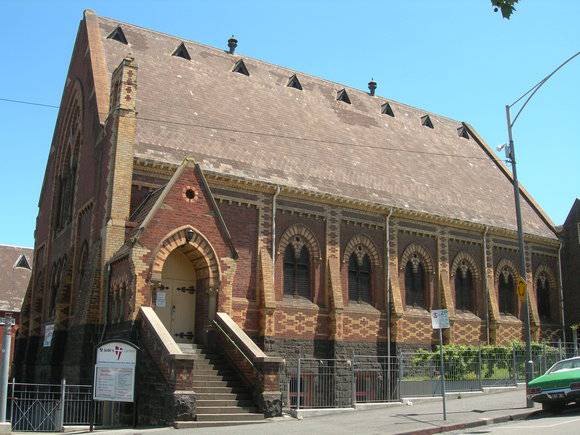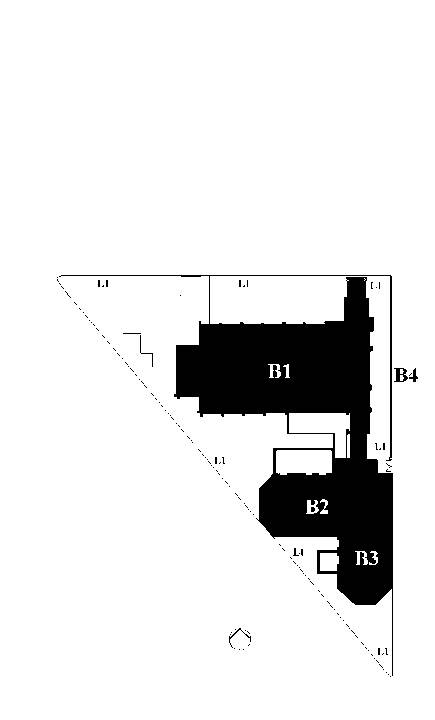| Back to search results » | Back to search page » |
|
ST JUDES ANGLICAN CHURCH
Location349-371 LYGON STREET AND 221-239 PALMERSTON STREET AND 2-34 KEPPEL STREET CARLTON, MELBOURNE CITY
File NumberPL-HE/03/1335LevelRegistered |
|
Statement of Significance
What is significant?
In 1866 St Jude's Church was a temporary wooden structure erected for
worship. From 1866-67 the chancel, four bays of the nave, and vestry of
the current church were erected to the designs of architects Reed &
Barnes. The contractor was John Pigdon. From 1869-70 the last four bays
of the nave, balcony, narthex and crypt were erected. In 1874 the south
porch and steps, area wall, iron railings and Lygon Street gates were
erected. The church is a Gothic-polychrome building erected on a high
bluestone plinth with dark hawthorn brick walls and red and cream brick
quoining, diaperwork and window surrounds. The plastered interior
includes a western gallery, an early pipe organ, and stained glass by
several prominent makers, including Ferguson & Urie, Rogers &
Hughes, Brooks Robinson, and William Montgomery. George Fincham of the
firm Finch and Fincham built the pipe organ contained in St Jude's in
1866. It was installed in the west end gallery of St Jude's when it
opened on 17 September 1872. The organ is enclosed in a painted timber
case of roughly 2000 x 2000mm base and 2500mm height. The display pipes
are of gilded metal with dust covers. In 1885 contractors Hiam &
Sons constructed a portion of the Lower Hall to the designs of Mr James.
The construction of the Lower Hall to its original design was never
completed. In 1891 however an Upper Hall was erected abutting the Lower
Hall to the designs of architects Reed Smart and Tappin. The designs of
the Upper and Lower Halls are not as elaborate as the main church
building, but are a simplified version of the details. The bricks on the
Upper Hall around openings have been surfaced in different colours to
imitate polychrome and the Lower Hall has bi-chrome brickwork.
How is it significant?
St Jude's Anglican Church is of architectural, aesthetic, historical and
scientific significance to the State of Victoria.
Why is it significant?
St Jude's Anglican Church is of architectural significance as it is an
early example of Gothic-polychrome and one of the first fully
polychromatic brick churches in Australia. The exterior of the building
demonstrates fully developed polychromy, with red and cream bricks
against a brown background in quoining, diaperwork and window surrounds;
the last deriving explicitly from Italian examples published by Street
and Ruskin. The Reedian polychrome became the cradle for a whole family
of innovative styles in red brick. St Jude's is of further architectural
significance for its associations with the well-known firm Reed &
Barnes. The firm later became Reed Smart & Tappin and was involved
with the design of the Lower Hall. The Upper and Lower Halls, while not
as elaborate are of significance for their architectural detailing
derived from the main church building. St Judes Anglican Church is of
aesthetic significance as a complex of early brick buildings, which are
a prominent landmark in Carlton.
The Organ contained in St Judes Anglican Church is historically and
scientifically important as an early substantially intact organ designed
by leading nineteenth century Victorian organ builder George Fincham.
Fincham arrived in Australia in 1852 and began his organ building
business in 1862 in which he achieved a level of perfection in organ
building such that his best organs were able to compare favourably with
imported English organs. The organs hand-blowing apparatus still
functions and the original key, stop, and combination actions are still
present. Positions of four former fittings on the vertical pillars of
the casework are visible and the timber organ bench still exists. St
Judes Anglican Church is of historical significance as an intact complex
of church buildings constructed before the turn of the century,
demonstrating the early growth of the Church of England in Melbourne.
Group
Religion
Category
Church










